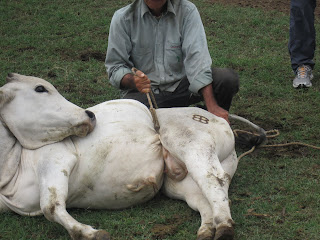THIS MAY BE FAR MORE DISTURBING THAN THE KILLING AND BUTCHERING OF THE CHICKEN. IT WAS FOR ME. DO NOT READ IF YOU DO NOT WANT GRAPHIC DETAILS.
**Editor's note: We wore pretty much the same clothes every single day on the ranch. Hence, many days, many events, all same clothes.You have been warned.
Gustavo has some 120 cows on his land, many of them young calves. At about six months, all of them are branded with his ranch’s
marca, a double B symbol that stands for his family name, Bermeo Blackburn. As productive, expensive animals,
la marca is incredibly important for when the animals get lost, or are sold.

The iron brand is heated up in a fire of dried bamboo, then used on the right flank of each cow. It sizzles and smokes, and the cow bellows. It smells bad, but it’s over quickly. It heals in about a day.


At six months, he and his ranch hands also castrate the young
toros in order to prevent natural reproduction. (Gustavo explained that it’s dangerous for the cows to mate naturally, as inbreeding will lead to weak, unproductive animals more prone to disease. Gustavo has three adult
toros that father all of the animals and is considering starting artificial insemination.) The instruments used in the surgery – basically a sharp paring knife, a pot of water, and antiseptic powder.

The young bulls have been separated from their mothers, and are already complaining when the process gets started. (Gustavo separates the young calves from their moms in the afternoons, so that they don’t drink all of their milk). Gustavo and Jose, one of his
trabajadores, rope and wrangle the bulls one by one, using a
botalon (basically a Y-shaped, carved tree) in the center of the corral for leverage.

Once the bull is roped, they pulled it so that it lays down on its side. Then Jose roped its legs together tightly and pulls its tail out of the way. No matter how much the bull thrashes, it can’t move far.

Then Gustavo does the surgery. First, he wets the bull’s scrotum, then slices off about a 2-inch square bit of loose skin, dropping it in the pot (to be later fed to the dogs). This is when the bull seems to react the most, though what happens next can’t be any less painful.

The two huevos slide out, or are massaged out by Gustavo. He slices open the sac, and pulls each testicle out by hand. It is attached by a tendon, so he twists the tendon over and over again, creating a tight coagulated seal, and eventually it snaps off. It makes a horrible sound, yet weirdly, the cow doesn’t seem to respond to this much. It’s repeated again for the second testicle.

Then, Gustavo shakes antiseptic powder into the scrotal wound, and Jose unravels the rope.

The cow jumps up pretty quickly. In five days, the opening will be healed completely, and Gustavo, who is proud of his methodology, has never had a bull develop an infection.
We castrated 7 bulls yesterday. It sucked.

Since we eat everything here, Patricia prepared the
huevos for breakfast. She salted them overnight, giving discarded bits to the dogs, and in the morning, fried them with garlic.


We ate them with
papas and
arepitas.



This, for me, was a gamechanger. I have happily eaten a bazillion burgers and steaks and sweetmeats in my life, marveling at the marbling and debating different cuts. I’ve spent months tinkering with meat recipes, braising oxtail after shortrib, and have very proudly come up with what I think is the perfect ratio of veal to beef for my burgers. My beef purchases were always about flavor and an abstract sense that I wanted the cow to have lived a nice life – not about the fact that I was killing it. I never once considered that I shouldn’t buy leather.
Gustavo and Patricia live on this land and respect it, and all the life on it. I understand why Gustavo castrates and brands his cattle. It’s part of the process that has brought every delicious filet I’ve ever eaten to my mouth, and probably Gustavo did it with more love and respect for the animals than any of the commercial cattle farms I’ve bought beef from during my life. This is his livelihood. Once the cows are slaughtered for beef, the skins are sold for leather. I am sitting on a leather chair with their neighbor’s
marca on it right now, and I respect that.
But I can’t do it. I watched those young young bulls thrash around in the corral, bellowing angrily and plaintively for help, their bodies twisted with ropes and pain. The worst moment is when after a few minutes of thrashing around in the dirt and manure, they lay their heads down in defeat. They looked at me with what honest to fucking god felt like shame. I could have drowned in it.
Did you know cows have eyelashes?
So, that’s it for me. I now know that I most certainly could not even attempt to kill a cow, and so cows are off the list of animals I will eat. I ate the fried cow testicles in the morning because they should not go to waste, and because Patricia prepared them with love. But no more.
Also …
OMG I NEVER THOUGHT I WOULD SAY SUCH THINGS JESUS CHRIST AM I NEVER GOING TO HAVE ANOTHER PIECE OF GALBI IN MY LIFE ?!





































